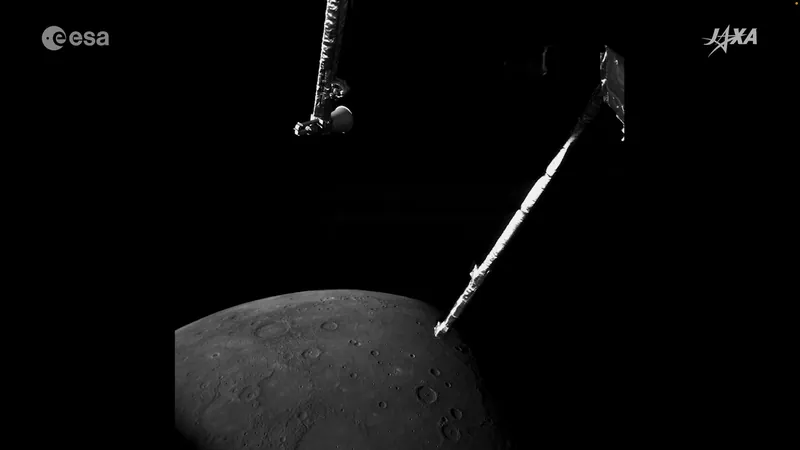
BepiColombo's Final Mercury Flyby Captured in Stunning Imagery!
2025-01-14
Author: Wei Ling
BepiColombo's Final Flyby of Mercury
The European Space Agency (ESA) and Japan Aerospace Exploration Agency (JAXA) have released breathtaking footage of BepiColombo's sixth and final flyby of Mercury, the smallest planet in our Solar System. This remarkable event occurred on January 7 and 8, 2025, marking a pivotal moment in the spacecraft's mission to study Mercury before it enters orbit around the planet in late 2026.
Capturing the Approach
As the video begins, viewers will witness BepiColombo's approach, captured by onboard monitoring cameras known as M-CAM 1 and M-CAM 2 between 16:59 CET on January 7 and 01:45 CET on January 8. During this critical phase, the spacecraft moved from a distance of 106,019 km to just 42,513 km from Mercury’s surface. Spectacular images show the spacecraft’s solar arrays and antennas as it maneuvers close to the planet.
Dramatic Close Approach
In a dramatic twist, Mercury appears to leap into view from behind the solar array, with the spacecraft rotating to prepare for its passage through the planet’s cold, dark shadow. The closest approach, occurring in darkness at 06:58:52 CET on January 8, saw BepiColombo come within a mere 295 km of Mercury’s surface, offering an unparalleled view of its terrain.
Exploring Mercury's North Pole
Once in the light, BepiColombo focused on Mercury's north pole, revealing various craters, including the prominent Prokofiev crater. The long shadows cast by the central peak of Prokofiev enhance its rugged landscape, showcasing the planet's geological complexity.
A Glimpse of Mercury's Geology
The journey also features views of Mercury gliding gracefully across the cameras' fields of view. The images reveal Mercury's northern plains, shaped billions of years ago by volcanic activity that smoothly covered its cratered surface with flowing lava.
Cultural Touch with Music
Adding a cultural touch, the video features the enchanting "Hebrides Overture" by Felix Mendelssohn, inspired by his visit to Fingal’s Cave in Scotland. Parallels can be drawn to Mercury's Mendelssohn crater, which was reshaped by a similar volcanic event that flooded it with lava post-impact.
The Journey Ahead
As the video draws to a close, viewers witness the last three close-up images captured by BepiColombo's monitoring cameras. Though these cameras will continue to function until September 2026, they will be separated from the spacecraft's main modules, including ESA’s Mercury Planetary Orbiter (MPO) and JAXA’s Mercury Magnetospheric Orbiter (Mio). The MPO will then take over with its advanced scientific cameras, set to explore Mercury in a detailed spectrum of visible and infrared light.
Conclusion
This extraordinary mission not only brings us closer to understanding our Solar System but also builds anticipation for the groundbreaking discoveries that lie ahead as BepiColombo prepares to study the enigmatic planet in detail. Keep your eyes peeled for more celestial wonders, as the adventure in our cosmic neighborhood continues!

 Brasil (PT)
Brasil (PT)
 Canada (EN)
Canada (EN)
 Chile (ES)
Chile (ES)
 Česko (CS)
Česko (CS)
 대한민국 (KO)
대한민국 (KO)
 España (ES)
España (ES)
 France (FR)
France (FR)
 Hong Kong (EN)
Hong Kong (EN)
 Italia (IT)
Italia (IT)
 日本 (JA)
日本 (JA)
 Magyarország (HU)
Magyarország (HU)
 Norge (NO)
Norge (NO)
 Polska (PL)
Polska (PL)
 Schweiz (DE)
Schweiz (DE)
 Singapore (EN)
Singapore (EN)
 Sverige (SV)
Sverige (SV)
 Suomi (FI)
Suomi (FI)
 Türkiye (TR)
Türkiye (TR)
 الإمارات العربية المتحدة (AR)
الإمارات العربية المتحدة (AR)